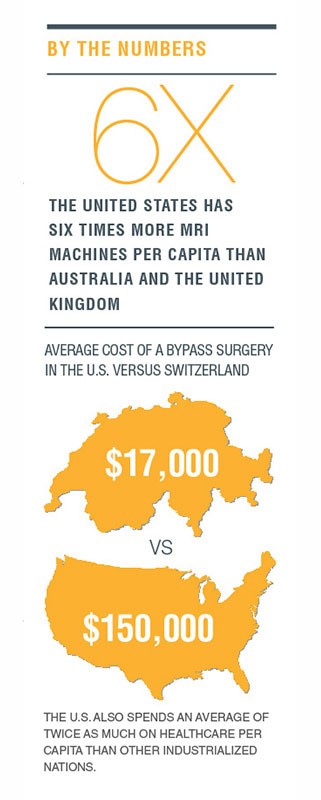Indispensability
Consumer industries have long known the secret to capturing and retaining customers: offer the best products and services for the price. Anyone who has ever owned a luxury vehicle no longer wants to live without exceptional service, especially when something goes wrong. (tweet this!) To gain and keep loyal customers, healthcare leaders would do well to become equally indispensable with patients, payers, and the community. This means improving every aspect of service, whether it’s in the primary physician’s hospital, the specialist’s office, or even the patient’s home.
“As a patient, healthcare can be very daunting, so we’re finding ways to ease their navigation, making sure that we address what their expectations are,” says William Dinsmoor, chief financial officer of the Nebraska Medical Center, a nationally ranked hospital in Omaha. Technological innovation is key to that mission; for example, the use of the latest electronic medical record systems, accessible along every step of the patient’s medical journey, translates to speedier, more efficient care. Similarly, technology that tracks every aspect of a patient’s care, from registration to outpatient billing — (tweet this!) like the Epic Systems suite of healthcare software — can help identify and eliminate medical redundancies, thus driving down patient costs.
Healthcare organizations also need to stake their claims as the go-to centers for healthcare information, now more than ever before. “As we experience changes in healthcare systems, medicine is moving beyond the hospital’s four walls and out to community settings, from community-based organizations to tele-health settings to retail health clinics,” says Thomas Concannon, Ph.D., a policy researcher at the RAND Corporation. “Hospitals needs to be thinking about taking the reins and trying to create and sustain a place where stakeholders can come together.”
Concannon believes that bidirectional communication is essential, even if many medical centers — academic and research institutions, for example — haven’t done much of it in the past. In that spirit, creating transparency is the obvious place to start, beginning with clarity on pricing strategies, which today, quite literally, are all over the map.
For instance, on average, (tweet this!) the U.S. spends twice as much on healthcare per capita than other industrialized nations; the same bypass surgery a citizen of Switzerland receives for $17,000 will set Americans back about $150,000.These huge discrepancies have resulted in a growth of so-called “medical tourism,” where patients travel to places like Belgium or South Korea to receive operations at a fraction of the price that they’d pay at home.
In this global environment, how do American healthcare systems make themselves competitive with their international counterparts? How do they prevent the people they serve from going to the other provider down the block — let alone to the other provider overseas?
 In other countries around the world, patients have ready access to price lists for the procedures offered at a hospital or clinic, a service scarcely imaginable to most Americans. “There’s been a lot of recent attention to hospital pricing strategies in the U.S.,” says Concannon. “These are not transparent strategies. It would be nice to see improved transparency in impatient stay, to see all the costs that go into materials, labor, and residential care.”
In other countries around the world, patients have ready access to price lists for the procedures offered at a hospital or clinic, a service scarcely imaginable to most Americans. “There’s been a lot of recent attention to hospital pricing strategies in the U.S.,” says Concannon. “These are not transparent strategies. It would be nice to see improved transparency in impatient stay, to see all the costs that go into materials, labor, and residential care.”
As more and more Americans learn just how much less their overseas counterparts have to pay for each visit or procedure, there have been increasing calls for change. A good place to look is Canada, says Colin Busby, senior policy analyst at the C.D. Howe Institute, a Toronto-based think tank. There, healthcare centers in some provinces are slowly moving from a fee-for-service system to a more blended payment model. In that model, family doctors are paid on a per-patient basis and encouraged to enroll a large number of patients — basically, the Accountable Care Organization (ACO) model many physicians are aiming for here. “By paying them per patient, the incentive on a physician is to only spend their time with their sickest patients,” he says, “and to try to keep everyone else healthy.”
In addition to lowering prices, healthcare providers can also boost their desirability by offering services that their patients simply can’t receive from their competition. “What we do is provide a very high quality product,” says Dinsmoor. “And we provide very specialized services. We do things that nobody else can.”
In the U.S., the drive toward more and more advanced medical technologies is another big reason for the country’s escalating healthcare costs; for example, America has six times more magnetic resonance imaging (MRI) machines per capita than Australia and the United Kingdom.
But lest one think that Dinsmoor is just playing the medical equipment arms race — “our proton therapy treatment program is better than yours” — that’s just one part of the picture. Those services Dinsmoor is talking about aren’t just hinged on having the latest, greatest medical devices, although that’s certainly a factor. The service component is part of a larger package of customer relations.
Central to this is the understanding that physicians and patients are all in this thing together. “Shared responsibility is huge,” says Dr. Carlos Jaén, chair of the University of Texas Health Science Center at San Antonio, Family & Community Medicine. “We’re here to be partners. If you’re ready to do it, I’m happy to help you. But it’s up to you, really. It’s your life.”
This idea of “shared responsibility” (both in terms of taking care of one’s own health and paying one’s fair share for services) is one that’s built into the systems of countries like France, Belgium, and Japan.
When patients decide to become more proactive about their healthcare, education and wellness centers will play a key role in the future. “I think patient education is extremely important,” says Dinsmoor, who cites the health management program Simply Well as a step in the right direction. “It’s a tool that employers can use to help screen and identify opportunities to improve their employees’ health status,” he says. “If we want to bend the cost curve in healthcare, we’ll need to shift resources from the back end, from the complicated intervention, to more prevention.”
Ironically, finding ways for doctors to see patients less — albeit by keeping them well — might be the best way to increase patient satisfaction. Nobody likes being sick, after all, no matter how efficient or professional the care at their hospital might be. And while patient satisfaction might be a key component, perhaps the most important component of making a healthcare provider indispensable to its patients and payers, getting patients to take responsibility for their own health, is often one of the toughest things for doctors to do.
Although some regions of the world are further along than others, forging stronger shared responsibility is a place where the new U.S. model, driven by the Affordable Care Act, could well stake a claim. “That’s the challenge with the ACA: How are the individuals going to be engaged with this?” says Dinsmoor. “What’s their responsibility? And that’s the piece that’s been missing. The delivery system is getting organized to do it, but how do you get the individual engaged? There are some people that are very engaged with it, but there are lots of people that are not. And underlying that is education, and taking ownership of your own health status.”
CRITICAL STUDIES FACTOR
Indispensability: A healthcare system must make itself indispensable with an offering that healthcare community residents, patients, and payers cannot (and will not) avoid or go around.



